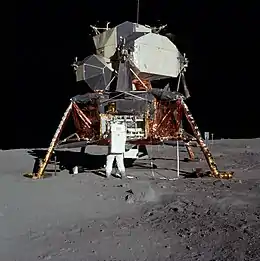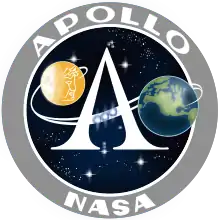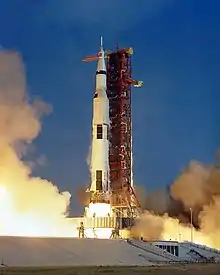Lunar Module Eagle
Lunar Module Eagle (LM-5) is the spacecraft that served as the crewed lunar lander of Apollo 11, which was the first mission to land humans on the Moon. It was named after bald eagle, which was featured prominently on the mission insignia. It flew from Earth to lunar orbit on the command module Columbia, and then was flown to the Moon on July 20, 1969, by astronaut Neil Armstrong with navigational assistance from Buzz Aldrin. Eagle's landing created Tranquility Base, named by Armstrong and Aldrin and first announced upon the module's touchdown.
| Eagle | |
|---|---|
| Part of Apollo 11 | |
 Eagle on the Tranquility Base on July 20, 1969 | |
| Type | Lunar module |
| Class | Apollo Lunar Module |
| Named after | Bald eagle |
| Manufacturer | Grumman |
| Construction number | LM-5 |
| Technical details | |
| Launch mass | 33,294.5 lb (15,102.1 kg)[1] |
| Landing mass | 16,153.2 lb (7,327.0 kg)[1] |
| Flight history | |
| Launch date | July 16, 1969 |
| Launch site | Kennedy LC-39A |
| Owners and operators | NASA |
| Landing date | July 20, 1969 |
| Landing site | Tranquility Base |
| Total hours | 130[lower-alpha 1] |
| Fate |
|
 |
| Part of a series on |
| Apollo 11 |
|---|
|
There were several differences between Eagle and Apollo 10's LM-4 Snoopy; Eagle had a VHF radio antenna to facilitate communication with the astronauts during their EVA on the lunar surface; a lighter ascent engine; more thermal protection on the landing gear; and a package of scientific experiments known as the Early Apollo Scientific Experiments Package (EASEP).[2][3]
The descent stage of Eagle remains on the Moon. In 2009, the Lunar Reconnaissance Orbiter (LRO) imaged the various Apollo landing sites on the surface of the Moon, for the first time with sufficient resolution to see the descent stages of the lunar modules, scientific instruments, and foot trails made by the astronauts.[4] The remains of the ascent stage lie at an unknown location on the lunar surface, after being abandoned and impacting the Moon.
Flight
Eagle was launched with Columbia on July 16, 1969 atop a Saturn V launch vehicle from Launch Complex 39A, and entered Earth orbit 12 minutes later. The LM was pushed onto its trajectory toward the Moon with the trans-lunar injection (TLI) burn. About 30 minutes later, the transposition, docking, and extraction maneuver was performed, which extracted the LM from the S-IVB upper stage.
Eagle entered lunar orbit on July 19, 1969. On July 20, Neil Armstrong and Buzz Aldrin entered into the LM and separated it from CSM. Five minutes into the descent burn, and 6,000 feet (1,800 m) above the surface of the Moon, the LM guidance computer (LGC) distracted the crew with the first of several unexpected 1201 and 1202 program alarms. Inside Mission Control Center, computer engineer Jack Garman told Guidance Officer Steve Bales it was safe to continue the descent, and this was relayed to the crew.
Eagle was landed at 20:17:40 UTC on July 20, 1969 with 216 pounds (98 kg) of usable fuel remaining. At 02:51 Armstrong began his descent to the lunar surface. While still on the ladder, Armstrong uncovered a plaque mounted on the LM descent stage bearing two drawings of Earth (of the Western and Eastern Hemispheres), an inscription, and signatures of the astronauts and President Nixon. The inscription read:
Here men from the planet Earth first set foot upon the Moon July 1969, A. D. We came in peace for all mankind.[5]
After the lunar surface operations, Armstrong and Aldrin returned to the Lunar Module Eagle on July 21, 1969. With some difficulties the astronauts lifted film and two sample boxes containing 47.5 pounds (21.55 kg) of lunar surface material to the LM hatch using a flat cable pulley device called the Lunar Equipment Conveyor (LEC). After transferring to LM life support, the explorers lightened the ascent stage for the return to lunar orbit by tossing out their PLSS backpacks, lunar overshoes, an empty Hasselblad camera, and other equipment. The hatch was closed again at 05:11:13. They then pressurized the LM and settled down to sleep.[6]
While moving inside the cabin, Aldrin accidentally damaged the circuit breaker that would arm the main engine for lift off from the Moon. There was a concern this would prevent firing the engine, stranding them on the Moon. A felt-tip pen was sufficient to activate the switch.[6] After about seven hours of rest, the crew was awakened by Houston to prepare for the return flight. Two and a half hours later, at 17:54:00 UTC, they lifted off in Eagle's ascent stage to rejoin Michael Collins aboard Columbia in lunar orbit.
Eagle rendezvoused with Columbia at 21:24 UTC on July 21, and the two docked at 21:35. Eagle's ascent stage was jettisoned into lunar orbit at 23:41 and crashed on the lunar surface. The location is uncertain because Eagle ascent stage was not tracked after it was jettisoned, and the lunar gravity field is sufficiently non-uniform to make the orbit of the spacecraft unpredictable after a short time.[7]
Gallery
See also
| Wikimedia Commons has media related to Category:LM-5. |
Notes
- From Earth launch to second CSM undocking.
References
- "Selected Mission Weights". history.nasa.gov. Retrieved September 24, 2020.
- Benson, Charles D.; Faherty, William B. (1978). Moonport: A History of Apollo Launch Facilities and Operations (PDF). Washington, D.C.: NASA. p. 472. SP-4204. Retrieved September 22, 2018.
- "Scientific Experiments". Smithsonian Air and Space Museum. Retrieved September 22, 2018.
- "LRO Sees Apollo Landing Sites". NASA. July 17, 2009. Retrieved September 25, 2018.
- Jones, Eric M., ed. (1995). "One Small Step". Apollo 11 Lunar Surface Journal. NASA. Retrieved June 13, 2013.
- Jones, Eric M., ed. (1995). "Trying to Rest". Apollo 11 Lunar Surface Journal. NASA. Retrieved June 13, 2013.
- "Location of Apollo Lunar Modules". Smithsonian Air and Space Museum. Retrieved September 24, 2018.
.jpg.webp)

.jpg.webp)


